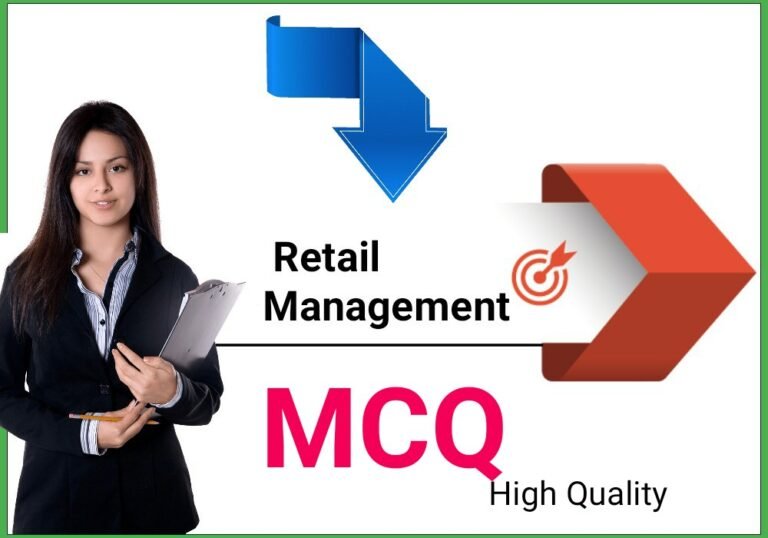MCQ on Inventory Management: Multiple choice questions with answers for MBA, BBA, and Finance Management students of various institutes.

MCQ on Inventory Management with answers
1. Which of the following is a type of inventory system that is used to manage independent demand items?
A. Order point system
B. Material Requirements Planning
C. Time-phased Order Point
D. Enterprise Resource Planning
Answer: (C)
2. Effective inventory management minimizes the investment in inventory by effectively meeting the___.
A. Functional requirement
B. Customer requirements
C. Process reliability
D. Sales forecasting of a firm
Answer: (A)
3. To achieve ___ in purchasing and transportation, goods may be purchased in larger quantities than the actual demand.
A. Continuation
B. Quality
C. Cost efficiency
D. Potential value
Answer: (C)
4. Which of the following is the objective of the enterprise resource planning system?
A. Manage purchase orders
B. Control the flow of dependent demand inventories
C. Organise external management information
D. Balance supply and demand
Answer: (D)
5. Which of the following models is used to calculate the timing of the inventory order?
A. Economic order quantity model
B. Fixed order quantity model
C. Reorder point model
D. Fixed order inventory model
Answer: (C)
6. The type of inventory method that comprises a greater number of accounting transactions is known as ___.
A. Periodic inventory method
B. Perpetual inventory system
C. Finished goods inventory method
D. Fixed order period inventory system
Answer: (B)
7. In the ABC Analysis system the B category stands for___.
A. Outstanding importance in value
B. Comparatively unimportant in value
C. Comparatively important in value
D. Average importance in value
Answer: (D)
8. Which among the following is a quantity of a specific item that is ordered from the supplier and issued as a standard quantity to the production process?
A. Safety stock
B. Lot size
C. Standard deviation
D. Inventory control
Answer: (B)
9. The economic order quantity formula is taken using ___.
A. Differential calculus
B. Integral calculus
C. Vector calculus
D. Multivariate analysis
Answer: (A)
10. Which among the following components is calculated as the sum of the fixed costs that happen each time an item is ordered?
A. Carrying cost
B. Order cost
C. Holding cost
D. Storing cost
Answer: (B)
11. The price reductions offered to customers for large orders, to encourage them to purchase in large quantities is known as ___.
A. Freebies
B. Quantity discounts
C. Normal discounts
D. Premiums
Answer: (B)
12. A company that maintains a sufficient safety margin by having extra inventory against certain situations is termed as ___.
A. inventory
B. lot size
C. safety stock
D. lead
Answer: (C)
13. Identify the mode of production that is widely used in a production model and in the assembly operations?
A. Round-robin mode
B. Batch mode
C. Grid mode
D. Parallel mode
Answer: (B)
14. Which among the following costs is the expense of storing inventory for a specified period of time?
A. Purchasing cost
B. Carrying cost
C. Financial cost
D. Storing cost
Answer: (B)
15. Which of the following is the ratio of net profit to net sales?
A. Net Operating ratio
B. Gross profit ratio
C. Pretax Profit ratio
D. Net profit ratio
Answer: (D)
16. A method that uses a predetermined overhead rate to allocate overhead costs is known as ___.
A. Plant-wide allocation
B. Shipping allocation
C. Department allocation
D. Production-wide allocation
Answer: (A)
17. Which of the following costs is estimated by multiplying the quantity determined in the bill of materials to the cost of each component?
A. Operating
B. Production
C. Labour
D. Material
Answer: (D)
18. A long-term solvency or leverage ratio is called ___.
A. Net profit ratio
B. Proprietary ratio
C. Activity ratio
D. Stock turnover ratio
Answer: (B)
19. Which among the following systems provides a process that enables one to track product movement throughout the company?
A. Item tracker system
B. Product locator system
C. Memory locator system
D. Real-time locator system
Answer: (B)
20. Pareto’s law is related to ___ placement theory.
A. Item stratification
B. Special consideration
C. Family grouping
D. Inventory stratification
Answer: (D)
21. Identify the system that allows you to have strong control over items without necessarily updating the location records?
A. Zoning systems
B. Fixed locator system
C. Zone locator system
D. Combining system
Answer: (B)
22. Manufacturers actually print the labels provided to them and serial numbers to aid in ___.
A. Quality audit
B. Quality control
C. Auditing process
D. Product quality
Answer: (B)
23. The method of item placement that can accidentally substitute an item onto another is ___.
A. Family grouping
B. Part grouping
C. ABC categorization
D. Category mapping
Answer: (A)
24. The movements of stock must be controlled with information regarding ___.
A. Space utilization
B. Order status
C. Labour utilization
D. Material protection
Answer: (B)
25. An alteration to the method of setting up zones or areas in the depot and assigning it to one person to each area is called ___.
A. Zone logic
B. Zone allocation
C. Sequential zone system
D. Random zone system
Answer: (C)
26. Which among the following refers to areas where items are not stored in selected permanent locations?
A. Fixed location
B. Random location
C. Location sequence
D. Pick-to-clear location
Answer: (B)
27. The expense of shifting the packed orders into vehicles that would ship them is known as ___.
A. Shipping cost
B. Packing cost
C. Loading cost
D. Picking cost
Answer: (C)
28. Distribution centers act as ___ storehouses of an organization.
A. Delivery
B. Regional
C. National
D. Procurement
Answer: (B)
29. The company should be prepared for any future demand from the customer by storing the ___ in the distribution centers.
A. Delivery stock
B. Strategic stock
C. Safety stock
D. Overhead stock
Answer: (C)
30. Which among the following systems deals with defining a well-defined process or procedure to manage distribution?
A. Logistics system
B. Pull distribution system
C. Inventory management system
D. Push distribution system
Answer: (A)
31. Which among the following improves the overall performance of the organization and helps to achieve efficient distribution and delivery system?
A. Just-in-Time
B. Master Production System
C. Customer responsiveness
D. Lead-time offsetting
Answer: (A)
32. The rules that govern a barcode are specified in the ___.
A. Codabar
B. Symbology
C. Database
D. Information system
Answer: (B)
33. The term used to denote a stacked 2D symbology is ___.
A. Determinant
B. Group
C. Matrix
D. Barcode list
Answer: (C)
34. Which of the following code sets include all standard alphanumeric keyboard characters along with lower case alpha and special characters?
A. Code set A
B. Code set B
C. Code set C
D. Code set D
Answer: (B)
35. The most common symbologies are Code 39, ___, and UPC.
A. Code 25
B. Code 93
C. Code 128
D. Code 11
Answer: (C)
36. Which of the following uses the CCD technology?
A. Cell phone cameras
B. Pen type readers
C. Laser scanners
D. Video camera readers
Answer: (D)
37. By finding out the number of times a company places orders one can calculate its ___.
A. Min-max system
B. Product demand
C. Evaluation phase
D. Review cycle
Answer: (D)
38. By knowing the ___, a company would know the cost of items that have to be refilled or added to inventory.
A. Selling cost
B. Buying cost
C. Replenishment cost
D. Differentiation cost
Answer: (C)
39. Which among the following is a computerized system that controls the kind of items to be purchased and also decides on the quantity that needs to be purchased?
A. Order point system
B. Material Requirements Planning
C. Time Phased Order Point
D. Enterprise Resource Planning
Answer: (B)
40. Identify the measure taken to deal with the issues relating to not having the right item at the right place at the right time.
A. Increase on-hand safety stock
B. Increase the inventory stock
C. Decrease the inventory stock
D. Decrease the safety stock
Answer: (A)
41. State True or False:
1. Raw materials can be produced and extracted by a firm or can be purchased from outside the firm.
2. Work in-process items are the inventory items that are not ready to be used by the customer.
A. 1-True, 2-True
B. 1-False, 2-False
C. 1-True, 2-False
D. 1-False, 2-True
Answer: (A)
42. The objective of maximizing ___ conflicts with minimizing ___ in inventory.
A. Purchase, investment
B. Production, cost-efficiency
C. Profit, negative cash flow
D. Storage capacity, loss
Answer: (A)
43. Assume that you are responsible for managing inventory in your organization. As a result of an increase in the demand for your company’s products, you have purchased lots of inventory at a time. On what basis will you categorize the huge inventory accumulated in your firm?
1. Based on the source of demand
2. Based on the position of inventory
3. Based on the size of the inventory
4. Based on the function of inventory
A. 1, 2 & 4
B. 1, 3 & 2
C. 2, 3 & 4
D. 1, 2, 3 & 4
Answer: (A)
44. State True or False:
1. Examples of MRO goods are oils, lubricants, coolants, packing material, tools, nuts, bolts, and screws.
2. Higher the buffer inventory better is the customer service.
A. 1-False, 2-False
B. 1-True, 2-False
C. 1-True, 2-True
D. 1-False, 2-True
Answer: (C)
45. State True or False
1. Time-based ordering model involves greater risk.
2. Time based ordering model has the possibility of inventory running out before its review is complete.
A. 1-False, 2-True
B. 1-False, 2-False
C. 1-True, 2-False
D. 1-True, 2-True
Answer: (D)
46. State True or False
1. While drawing strategies to develop efficient logistics for a company, the manager has to focus on capital reduction and cost reduction objectives.
2. The selection of means of transportation depends on the location of the customer and the time within which the product has to be delivered to the customer.
A. 1-True, 2-False
B. 1-False, 2-True
C. 1-True, 2-True
D. 1-False, 2-False
Answer: (C)
47. The time period between placing two successive orders is called ___ and the time period between ordering an item for replenishment and actually receiving the item into the inventory is called ___.
A. Lead time, order cycle
B. Order cycle, lead time
C. OTC cycle, idle time
D. Idle time, OTC cycle
Answer: (B)
48. Reorder point = ___ + ___
A. Lead time demand, safety stock
B. Forecasted daily unit sale, lead time
C. Reorder point, lead time demand
D. Safety level of stock, demand per day
Answer: (A)
49. Inventory carrying costs consists of ___ and ___.
A. Shipping cost, storage cost
B. Handling cost, storage space cost
C. Vendor cost, physical management cost
D. Storage cost, physical management cost
Answer: (D)
50. Which of the following are the factors that determine inventory levels?
A. Vendor delivery and storage cost
B. Item perishability and storage capacity
C. Spoilage and cost of tracking inventory
D. Item cost and vendor delivery
Answer: (B)
51. Identify the two components that make up the EOQ equation.
A. Order cost, setup cost
B. Quality cost, setup cost
C. Annual usage, carrying cost
D. Quality cost, annual usage
Answer: (C)
52. State True or False
1. Safety stock can be set in weeks or units of stock at the simplest level.
2. The larger the lot size, the fewer is the number of lots required, and hence higher is the annual set-up cost.
A. 1-False, 2-True
B. 1-True, 2-True
C. 1-True, 2-False
D. 1-False, 2-False
Answer: (C)
53. Which of the following are the factors to be considered while calculating safety stock?
A. Adjusted service level, annual usage
B. Ordering period, cycle time
C. Cycle time, forecast error
D. Forecast error desired service level
Answer: (D)
54. Identify the two ways used to measure the service level.
A. Unit Service Level (USL), Demand Service Level (DSL)
B. Order Service Level (OSL), Unit Service Level (USL)
C. Order Service Level (OSL), Demand Service Level (DSL)
D. Production Service Level (PSL), Unit Service Level (USL)
Answer: (B)
55. State True or False
1. LILO tracking is the preferred approach for tracking items with a short shelf life as pickers usually access the oldest items first without any need for computer tracking.
2. Executives and shareholders need to fully understand supply chain implications to keep track of the inventory levels.
A. 1-True, 2-False
B. 1-False, 2-True
C. 1-True, 2-True
D. 1-False, 2-False
Answer: (B)
56. Which of the following are the methods used to treat the obsolete stock?
A. Create a Materials Review Board (MRB), track the rework status actively
B. Specific identification, track work status actively
C. Track work status actively, create a Material Check Board (MCB)
D. Track purchase order, create a Materials Review Board (MRB), and Track the rework status actively
Answer: (A)
57. Inventory turnover ratio = ___ / ___.
A. Beginning inventory, total goods sold
B. Average inventory at cost, ending inventory
C. Cost of goods sold, average inventory at cost
D. Total goods sold, cost of goods sold
Answer: (C)
58. Which among the following are the overhead activities used to produce snowmobiles and riding mowers?
A. Admission, pathological testing
B. Dietary and laundry, engineering changes, and quality-control inspections
C. Engineering changes, quality-control inspections
D. Radiological testing, quality-control inspections
Answer: (C)
59. State True or False
1. Fabrication activity is labour-intensive which involves assembling machined pieces (components or parts) manually into a final product.
2. When the acid-test and current ratio are low it indicates that the supplier has a cash problem.
A. 1-False, 2-False
B. 1-True, 2-True
C. 1-False, 2-True
D. 1-True, 2-False
Answer: (C)
60. State True or False
1. All barcode readers consist of decoder circuitry.
2. The sensors present in the scanner provide the barcode’s image data to the circuitry.
A. 1-True, 2-False
B. 1-False, 2-True
C. 1-False, 2-False
D. 1-True, 2-True
Answer: (D)
61. Which software is recommended for doing inventory management?
A. Excel Spreadsheet
B. Proest
C. Microsoft Word
D. Photoshop
Answer: (B) Proest
62. Which of the following is true for inventory control?
A. It is only relevant for small businesses
B. It helps in minimizing costs related to overstocking
C. It is solely focused on increasing stock levels
D. It has no impact on operational efficiency
Answer: (B) It helps in minimizing costs related to overstocking
63. Proest is used for different management tasks such as asset inventory.
A. True
B. False
Answer: (A) True
64. Which of the following is not an inventory?
A. Raw Materials
B. Finished Products
C. Work-in-Progress
D. Material Management
Answer: (D) Material Management
Marketing Management and Service Marketing MCQs with Answers
Conclusion Points
Thanks for visiting our website, if you like the post on MCQ on Inventory Management, please share the post on social media. If you have any query ask through below comment box.



